Text
Coca-Cola de grote weldoener; als we deze advertentie moeten geloven...

Ik kon mijn ogen niet geloven toen een foodwatcher mij deze advertentie toestuurde. Op de afbeelding zien we een flesje en een ingeschonken glas Coca-Cola Zero met een bord sla met wat croutons ernaast. De tekst op de afbeelding luidt:
"Wij helpen mensen hun suikeriname te reduceren. Door suikerreductie, nieuwe producten, kleinere verpakkingen en met onze marketingcampagnes."
Zo lijkt het alsof de Coca-Cola Company echt lekker begaan is met onze gezondheid toch?
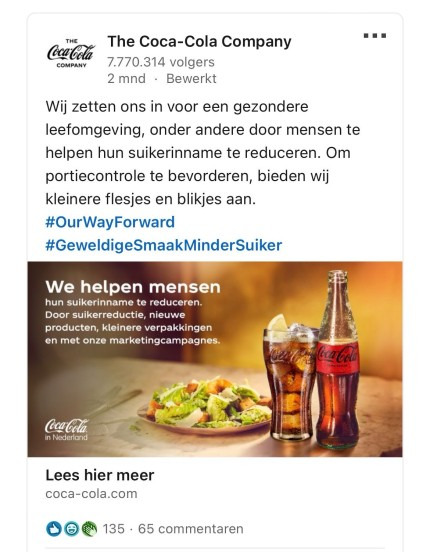
Cola drinken is niet gezond
Coca-Cola claimt dat een product als Coca-Cola Zero helpt bij het reduceren van suikerinname en suggereert dat het samen met een groene salade past in een gezond voedingspatroon, maar de werkelijkheid is minder rooskleurig. Ook volgens het Voedingscentrum zijn frisdranken, zowel suikerhoudende als suikervrije, schadelijk voor de gezondheid. Suikerhoudende dranken verhogen het risico op obesitas en diabetes type 2, terwijl de zuren in (suikervrije) dranken, zoals Coca-Cola Zero, schadelijk zijn voor het gebit.
Bovendien stellen verschillende onderzoeken dat kunstmatige zoetstoffen beter vermeden kunnen worden om een gezond gewicht te behouden. Zo compenseren mensen die veel light- of zero sugar-producten consumeren hun gedrag vaak door meer regulier voedsel te eten, waardoor ze toch meer calorieën binnenkrijgen dan ze nodig hebben. De frisdrank staat dan ook niet in de schijf van vijf. Water of thee zijn natuurlijk betere keuzes.
Dan moeten we het nog even hebben over het fenomeen portiecontrole. Coca-Cola zegt: "Door in te zetten op verpakkingen van 250 ml of minder, maken we het voor consumenten eenvoudiger om aan portiecontrole te doen." Maar is dit echt in het voordeel van de consument of gebeurt dit om de eigen portemonnee spekken? Als we naar de cijfers kijken is dit laatste waar.

Verrassing: naarmate de verpakkingen kleiner worden, stijgt de prijs per liter cola aanzienlijk. Dit geldt zowel voor reguliere Coca-Cola als voor Coca-Cola Zero. Je betaalt bijna het dubbele per liter voor een blikje van 150 ml in vergelijking met het blikje van 330 ml.
Foute vrienden
En hoe zit het met de genoemde gezonde marketingcampagnes? Coca-Cola gaat zelfs foute vriendschappen aan om de cola-consumptie nog eens extra op te voeren: kijk maar naar de samenwerking die het bedrijf is aangegaan met het chocokoekje OREO. De nieuwe ‘Limited Edition Cola’ die ‘fizzy cookie flavored’ is, nodigt fans uit om op Spotify de ‘Bestie Mode’ te activeren en een team te vormen met hun beste vrienden om hun vriendschap (en consumptie!) te vieren. Marketing voor onze gezondheid? Ik denk het niet.
Gezondere leefomgeving?
In de advertentie wordt ook gesteld dat Coca-Cola zich inzet voor een gezondere leefomgeving. Zo was Coca-Cola weer een van de sponsoren van de Olympische Spelen. Maar hoe kan een multinational, die steenrijk wordt met de verkoop van ongezonde frisdranken en daarmee ook het milieu vervuilt (200.000 plastic flessen per minuut!), een sponsor zijn van een evenement dat symbool staat voor gezondheid, sportiviteit en duurzaamheid?
Het Internationaal Olympisch Comité (IOC) heeft zich gecommitteerd aan de Paris Agreement on Climate Change, met als doel een duurzamere toekomst te bevorderen. Maar hoe kan het IOC deze belofte waarmaken terwijl ze samenwerken met een beroerd bedrijf als de Coca-Cola Company? Dit roept ernstige vragen op over de integriteit van dergelijke samenwerkingen. Zo zien we maar weer, als Coca-Cola ergens goed in is, is het in green en social washing (lees hier meer over de manieren waarop bedrijven hun imago opvijzelen).
Verschillende organisaties zijn een wereldwijde campagne gestart om het Olympisch Comité aan te sporen om de banden met Coca-Cola te verbreken. Ook wij steunen deze actie!
Topje van de ijsberg
Coca-Cola ligt al decennia onder vuur. En het blijft nodig om de kwalijke praktijken van Coca-Cola aan de kaak te stellen. De komende maanden zul je zeker nog van mij horen en ga ik dieper in op de verwoestende impact op het milieu, de uitbuiting van arbeiders, politieke inmenging en schendingen van mensenrechten wereldwijd van dit bedrijf, want deze multinational beïnvloedt ons allemaal. Stay tuned!
Met vriendelijke groeten,
Liz Kunst, campaigner
0 notes
Text
Agenda -
Advanced Composite Solar Sail System

Setting Sail to Travel Through Space: 5 Things to Know about our New Mission
Our Advanced Composite Solar Sail System will launch aboard Rocket Lab’s Electron rocket from the company’s Launch Complex 1 in Māhia, New Zealand no earlier than April 23, at 6 p.m. EDT. This mission will demonstrate the use of innovative materials and structures to deploy a next-generation solar sail from a CubeSat in low Earth orbit.
Here are five things to know about this upcoming mission:
1. Sailing on Sunshine
Solar sails use the pressure of sunlight for propulsion much like sailboats harness the wind, eliminating the need for rocket fuel after the spacecraft has launched. If all goes according to plan, this technology demonstration will help us test how the solar sail shape and design work in different orbits.

2. Small Package, Big Impact
The Advanced Composite Solar Sail System spacecraft is a CubeSat the size of a microwave, but when the package inside is fully unfurled, it will measure about 860 square feet (80 square meters) which is about the size of six parking spots. Once fully deployed, it will be the biggest, functional solar sail system – capable of controlled propulsion maneuvers – to be tested in space.

3. Second NASA Solar Sail in Space
If successful, the Advanced Composite Solar Sail System will be the second NASA solar sail to deploy in space, and not only will it be much larger, but this system will also test navigation capabilities to change the spacecraft’s orbit. This will help us gather data for future missions with even larger sails.

4. BOOM: Stronger, Lighter Booms
Just like a sailboat mast supports its cloth sails, a solar sail has support beams called booms that provide structure. The Advanced Composite Solar Sail System mission’s primary objective is to deploy a new type of boom. These booms are made from flexible polymer and carbon fiber materials that are stiffer and 75% lighter than previous boom designs. They can also be flattened and rolled like a tape measure. Two booms spanning the diagonal of the square (23 feet or about 7 meters in length) could be rolled up and fit into the palm of your hand!

5. It’s a bird...it’s a plane...it’s our solar sail!
About one to two months after launch, the Advanced Composite Solar Sail System spacecraft will deploy its booms and unfurl its solar sail. Because of its large size and reflective material, the spacecraft may be visible from Earth with the naked eye if the lighting conditions and orientation are just right!
To learn more about this mission that will inform future space travel and expand our understanding of our Sun and solar system, visit https://www.nasa.gov/mission/acs3/.
Make sure to follow us on Tumblr for your regular dose of space!
2K notes
·
View notes
Text
How a doping scandal could overshadow the Olympics


26/07/2024
The Olympics is here! Get ready for some truly awe-inspiring displays of athleticism. But there is also a scandal hovering over the Games in Paris that threatens to move focus away from the athletes.
Earlier this year, an investigation by German news channel ARD and the New York Times – which revealed that 23 Chinese swimmers had tested positive for the banned heart drug trimetazidine (TMZ) before the Tokyo Olympics in 2021 but were still allowed to compete in the Games – caused uproar in the world of competitive swimming.
The World Anti-Doping Agency (Wada) confirmed that while they had found the banned substance in the athletes, they accepted the findings of the investigation conducted by the Chinese Anti-Doping Agency, which claimed that the results were due to contamination from a hotel kitchen. There has been no explanation of how the prescription drug got into the kitchen and the food of nearly two dozen athletes. The case was also not made public at the time.
Three years later, 11 of those swimmers are competing in Paris, despite significant criticism from athletes and other regulatory bodies. Legendary swimmers Michael Phelps and Allison Schmitt went to a hearing on Capitol Hill to say that they had lost faith in the fairness of the Games.
For today’s newsletter, I spoke with Kieran Pender, a Guardian contributor who covers sport and law, on the doping scandal looming over the 2024 Games.

In depth: ‘Something could kick off at the pool in Paris’

Kieran arrived in a frenetic Paris on Sunday. “It’s a bit of a weird time before an Olympics begins, because there’s this real sense of anticipation,” he says. Many people are leaving the city for the summer, and even more are trying to avoid the impending chaos. Meanwhile, spectators are steadily arriving. “There’s a real excitement and a buzz,” Kieran adds.
It couldn’t feel more different from the last Games in Tokyo, where there were no spectators, and fans and athletes were largely isolated due to the pandemic. “That was such an unusual Olympics, and it’s remarkable that only three years later, life is, in many respects, back to normal,” he says. However, he adds that there is a small Covid outbreak in some teams, and several Olympic volunteers have resigned due to concerns over the lack of Covid safety measures.
This Olympics, like most others, faces several potential problems: protesters, disgruntled residents, and the biggest problem of all – a doping scandal that threatens the integrity of one of the sports.
‘Fraught times’
Doping scandals are, of course, nothing new, and nor is the anti-doping regime carried out by bodies such as Wada and Usada (US Anti-Doping Agency). Transparency over how those agencies operate is critical to ensure trust. “Typically when an athlete tests positive, they’re provisionally suspended and that’s made public while the anti-doping process runs its course,” Kieran says. That did not happen in the case of the Chinese swimmers in 2021, some of whom went on to win medals in Tokyo. Wada did not declare the results, and the team’s performance was one of the best in Chinese swimming history.
Wada says it followed the proper protocols, and that it was limited in what it could do due to pandemic restrictions in China. The explanation given by Wada and China’s own agency, Chinada, did not satisfy athletes, other regulatory bodies or government officials. Soon after the revelations became public, Wada appointed a special prosecutor to investigate how the regulator handled the positive results. Earlier this month, the independent review concluded that the agency’s decision was “indisputably reasonable”.
Critics have called into question the independence of the review, while anti-doping groups FairSport and Global Athlete said the process was “inherently flawed from the outset”. They added that, “until all related documents are made public, trust in the system will not be regained and Wada’s position as the global regulator will continue to be challenged”.
“These are fraught times,” says Kieran. “There are real concerns from a lot of swimmers about the integrity of the competition”. He also notes that these kinds of tensions are not novel – in 2019 the Australian swimmer Mack Horton protested against China’s Sun Yang at the world swimming titles because of doping allegations. “There’s every possibility that something really kicks off at the pool in Paris.”
The politics of it all
The International Olympic Committee met on Wednesday and formally awarded Salt Lake City the 2034 Winter Olympics, as was expected. Some IOC members, however, said that it should only be given to the US if their anti-doping agency stopped criticising Wada. “Salt Lake City has now been granted the 2034 Winter Games on the express condition that the US stop criticising the world anti-doping authority, and the local administration seek to have an FBI investigation into the allegations dropped. That’s remarkable,” Kieran says.
Fair play
Most of the swimmers that Kieran has spoken to, particularly on the Australian team, are troubled by the saga but have a level of resignation about the issue. “They have said, ‘it is what it is’ and ‘we just have to focus on our own race because we can’t control these other things’,” Kieran says.
He also highlights the punitive nature of the anti-doping regime for those who get caught in it: “there’s sort of a frustration among athletes that the system is harsh in some cases and then not in others, without explanation”. For instance, the Australian swimmer Shayna Jack – who also argued that something she ingested must have been contaminated – was forced to serve a two-year suspension from the sport despite the arbitrators in her case accepting that she had not intentionally taken performance-enhancing drugs. “For the integrity of the sport as a whole and for public confidence everyone has to feel that these frameworks are being fairly and evenly applied,” Kieran says.
Although this story will certainly dominate headlines, Kieran adds that he does not want it to detract from the competition. “There are some stellar matchups and I think this could be a historic Olympic swim meet,” he says. “While we need to scrutinise what’s happening away from the swim-deck, I think the swimming itself is going to be very exciting”.
0 notes
Text
Four years ago.

ACLU Supporter –
Four years ago tomorrow – May 25, 2020 – the murder of George Floyd in broad daylight by a Minneapolis police officer sparked the largest protests against police brutality in U.S. history. George Floyd should still be alive today.
Instead of sending this email tomorrow, we want to leave a moment of quiet space on Saturday for the families and communities who loved him – while taking a moment today to reflect on the reckoning that his loss continues to make clear in this country and across the globe.
We at the ACLU have for decades fought for change to our country's approach to policing and public safety. Public safety should always include safety from police violence.
Ending police abuse will require bold and sustained commitment across all levels of government to hold police accountable as well as collaboration with communities most harmed by police violence.
And this transformative approach to safety must include investments in housing, mental health services, healthcare, and alternative emergency response programs.
We will continue fighting for these changes relentlessly with and alongside the communities most impacted: No more lives should be needlessly lost at the hands of police.
Today, we invite you to learn more on this crucial work to achieve true public safety.
And as always, thank you for being with us in the fight for a more equal and just nation.
In solidarity,
The ACLU Team
0 notes
Text
Top of the Week: Protest rights on campuses are under attack

ACLU Supporter, as campus protests are still under threat at colleges and universities, we're on the ground across the country, prepared to act swiftly wherever our rights are violated.
At the top of the week, here are three major fights that we're taking on:
The ACLU of Indiana has sued Indiana University on behalf of protesters who were banned from campus after protesting in Dunn Meadow. Since 1969, this green space on campus has been a public forum where people go to express themselves. But the night before a protest in support of the Palestinian people, IU officials changed their policies, and then had police arrest protesters the next day for trespassing. The school then banned them from setting foot on campus for a year – effectively keeping them from joining both ongoing and future protests. This is a clear violation of protesters' First Amendment rights. Public universities like IU must protect free speech on campus. Read more about the ACLU of Indiana's legal response.
Some in Congress are trying to take advantage of tensions over campus protests to push a dangerous bill stifling speech. The House already passed a bill that gives the government virtually unfettered power to revoke the nonprofit status of any organization it accuses of supporting terrorists. It would allow the government to use secret evidence and an unfair process that makes it nearly impossible for a nonprofit to clear its name before it is effectively shut down. It could even be used to pressure publicly funded universities to silence student activism. These are the kinds of tactics authoritarian regimes use to target political opponents and stifle dissent. No presidential administration should have power like this. We just testified in Congress about the importance of protecting free speech in times of crisis – but we need you with us. Tell your Senators to vote no on this dangerous bill >>
The ACLU is fighting on every front – urging universities to protect students and faculty speaking out on issues that matter to them. Our podcast, At Liberty, spoke with lawyers at ACLU affiliates across the country to talk about ongoing legal action, the dangers of inviting police to respond to campus protests, and what to know about our protest rights at private and public colleges. Tune in to get the full story on the free speech issues on campuses.
Onward,
The ACLU Team
2024 pro-Palestinian protests on university campuses / Pro-Palestina studentenprotesten
0 notes
Text
Demonstratierecht bruut inperken is niet normaal!
Renske van DeGoedeZaak 13-05-2024
Het is je vast niet ontgaan: verschillende studenten in heel Nederland hebben hun universiteiten bezet om te eisen dat ze hun banden verbreken met Israëlische organisaties en instellingen [1]. Ook vandaag staan er, door het hele land, nieuwe ‘encampments’ in Delft, Maastricht, Eindhoven, Amsterdam, Nijmegen en Groningen. Deze encampments zijn bezettingen van universiteitsgrond uit solidariteit met het Palestijnse volk en andere studenten. Ondanks dat de protesten vreedzaam zijn, kregen Utrechtse en Amsterdamse demonstranten vorige week te maken met extreem politiegeweld.
Tegelijk wordt het narratief rondom het geweld bij protesten gekaapt door extreemrechtse partijen en gebruikt om ons demonstratierecht in te perken. Nadat de Koninklijke Academie van Beeldende Kunsten (KABK) in Den Haag aangaf de banden met Israëlische instituten te verbreken, stelde de BBB kamervragen. De BBB pleit om de bekostiging van de KABK na dit besluit per direct stop te zetten. In andere woorden: als je geen financiële banden met Israël wilt hebben, kan je als onderwijsinstelling niet meer op Nederlandse steun rekenen. Tot zover de academische vrijheid.
Dreigen met het weghouden van subsidie richting kritische onderwijsinstellingen is niet normaal. Sterker nog, het is een goedkope truc van extreemrechts om kritisch, onafhankelijk onderwijs af te schaffen. Om kritisch denken, diversiteit van meningen, burgerparticipatie en innovatie te waarborgen moet onderwijs tegengas kunnen geven, niet alleen maar herhalen wat onze overheid zegt. Het anti-intellectualisme past ook precies in het playbook van extreemrechts, iets waar wij ons hard tegen verzetten. Doe je mee aan onze landelijke beweging, om extreemrechts niet normaal te maken?
IK TEKEN MEE, DIT IS NIET NORMAAL
Terwijl Nederlandse politici ons recht op demonstreren bedreigen, vallen er dagelijks burgerslachtoffers in Palestina. Het offensief tegen Palestijnse burgers gaat onverminderd door. De continue focus op de vorm van de protesten leidt af van het feit dat het vluchtelingenkamp bij Rafah en het noorden van Gaza ingevallen worden door het Israëlische leger. Rutte zei eerder nog dat dat een brug te ver was, maar nu is het muisstil [2]. We moeten de politiek doorlopend verantwoordelijk blijven houden voor wat ze wel - of juist niet - doen. Jouw stem maakt hierbij het verschil!
IK DOE MEE
Met strijdbare groet,
Renske van DeGoedeZaak
P.S. Studenten zijn bij ons ook een petitie gestart tegen de identificatieplicht op universiteiten. Deze kun je hier tekenen.
[1] Volkskrant: Wat eisen de studenten eigenlijk?
[2] NOS: Rafah zou een ‘gamechanger’ zijn voor Rutte
Dit is niet normaal! Red onze Democratie en Rechtsstaat!
0 notes
Text
The US campus protest crisis | First Edition from the Guardian
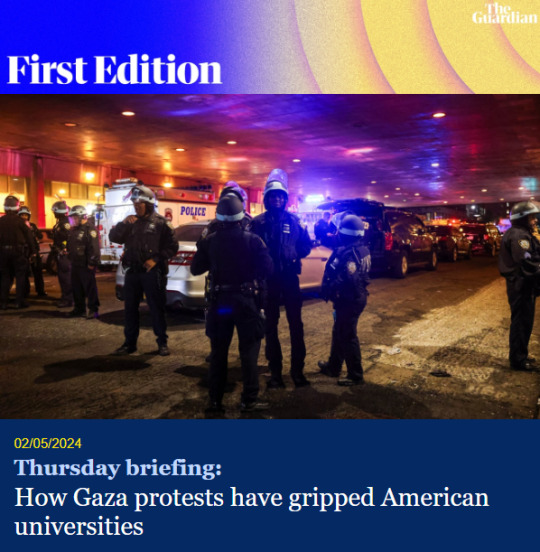
It’s only student politics, you might say: a collection of undergraduates staging protests on campus, making demands of university administrators, and registering a futile objection to a faraway crisis. Why should anyone else be interested?
But the protests over Israel’s invasion of Gaza that have convulsed Columbia University in New York are becoming harder and harder to dismiss, reminiscent to some of the anti-Vietnam war demonstrations of 1968. They have set off a wave of similar protests across the US, and now even in the UK. They have drawn attention to the extent of US support for Israel, and lent credence to claims that college administrators listen more closely to hostile Republicans than their own students and faculty.
On Tuesday night, police in riot gear arrested 119 people at Columbia, and counter-protesters launched a violent attack on a pro-Palestinian encampment at the University of California, Los Angeles. On Wednesday, police launched operations to dismantle protests in New York, Texas, Wisconsin, Louisiana and Arizona – and a few minutes ago, there were reports that hundreds of police in riot gear were surrounding the UCLA encampment.
All of this suggests that US college campuses are now the site of a major confrontation over free speech and the war in Gaza that is only likely to grow. For today’s newsletter, I spoke to Bassam Khawaja, a human rights lawyer and lecturer at Columbia Law School, about why he supports the protests, what they are seeking to achieve, and how they have escalated to a crisis point. Here are the headlines.

In depth: ‘This escalation didn’t come out of nowhere’
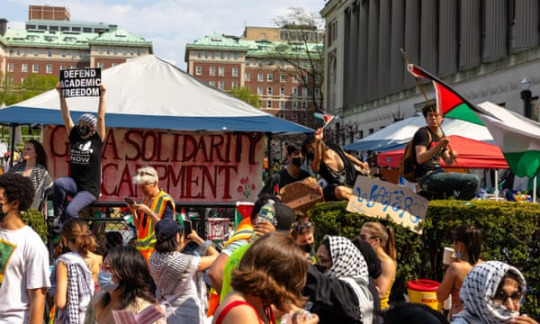
Protests began at universities across the US soon after the Hamas attack of 7 October, and spread as Israel’s invasion of Gaza intensified. Columbia, a potent symbol of the power of student activism thanks to its students’ key role in Vietnam and anti-apartheid protests, was at the centre of the movement from the start.
As early as November, Columbia suspended chapters of two groups, Jewish Voice for Peace and Students For Justice in Palestine, over an unauthorised walkout. Instead of quashing the protest, that action prompted the formation of a coalition of dozens of student organisations, under the CU Apartheid Divest (CUAD) umbrella. Now made up of 100 student-run groups, CUAD has called on the university to sell holdings in companies with significant financial ties to Israel.
It was CUAD that organised a protest encampment earlier this month – and it was the arrest of more than 100 protesters as their tents were cleared two weeks ago that ratcheted tensions up further. Columbia president Minouche Shafik requested the NYPD’s presence, calling the encampment “a clear and present danger”, and in doing so crossed the Rubicon.
“It was essentially students studying in tents,” Bassam Khawaja said. “It’s laughable to say that it was a danger.” Sending in the NYPD two weeks ago was, he said, “certainly an escalation – but it didn’t come out of nowhere. All the way through this, Columbia has chosen to escalate.”
What’s happened at Columbia this week
After the encampment was broken up, some of those who were involved simply started another on the next lawn over. Shortly after midnight on Tuesday, after the university started to suspend students who had refused to leave, a group of about 60 protesters – described by CUAD as an “autonomous subgroup” – moved to occupy Hamilton Hall, an academic building, and barricaded the doors. (New York magazine has an interesting set of pictures from inside the occupation.)
Columbia told the protesters that they would face expulsion, and issued a statement claiming that they were “led by individuals who are not affiliated with the university”; Joe Biden condemned the occupation. Once again, Shafik authorised the NYPD to come in, later highlighting the apparent presence of “outside activists” in a statement released on Wednesday. Police in riot gear marched on the campus and cleared the new encampment.
At least 50 officers used an armoured vehicle with a mechanical ramp to gain access to the second floor of Hamilton Hall. They used so-called “flashbang” grenades to disorient the occupiers, arrested them, and took them away in buses. According to student newspaper the Columbia Spectator, officers “threw a protester down the stairs in front of the building and slammed protesters with barricades”. You can see the location of the occupied building and encampment below.
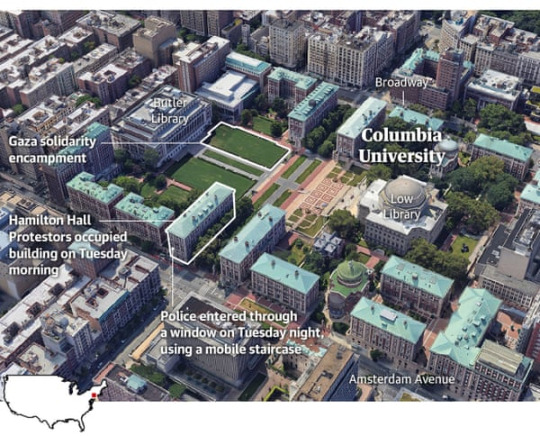
Here’s how Adam Tooze, the renowned economic historian and Columbia faculty member, described the scene as a police vehicle arrived:

On an order from their commander, the police pushed. They pushed hard. Very hard. They move fast, as quickly as their bulk and equipment would allow, maximizing momentum. The officers use waist-high steel barriers as plows to drive the protestors back and to pin them in side streets and against walls …
The scene was static. But I would not be honest if I did not say that my stomach churned watching it. The sheer force of the movement, the relentless and sudden drive of the steel barrier against human bodies, moved the air.
“People are absolutely furious,” Khawaja said. “The university has now twice called the police on the students who are supposed to be under our care. There is a good reason we don’t bring police on to campus – the NYPD has a history of violence against protesters. The administration knew, or should have known, that they were putting these students at risk.”
What the students want
At Columbia and elsewhere, they want to see a ceasefire and an end to the occupation of Gaza – but more locally, they make the case that their universities should divest from companies with links to Israel.
In this piece, Tooze points out how opaque Columbia’s financial reporting is – but also notes that the publicly known assets in question are worth a few million against a total endowment of almost $15bn. The real point, he argues, is to highlight “the way that a powerful educational institution like Columbia is embedded in networks of power and influence”.
There have also been documented cases of antisemitism. Although most appear to have been linked to protests just off campus by demonstrators unaffiliated with Columbia, some Jewish groups at the university hold the student organisations responsible for fomenting an atmosphere in which such abuse is more likely. Apartheid Divest has condemned and disowned such incidents and called the perpetrators “inflammatory individuals who do not represent us”.
Others have argued that it is unreasonable to tar the entire movement with the comments of a few. “Antisemitism has no place on a college campus,” said Khawaja. “There have been unacceptable incidents. But the idea that this is an antisemitic movement is simply incorrect. We have to have no tolerance for antisemitism, but [we want] to be able to speak up for Palestinian rights.”
How university administrators have handled it
The Columbia encampment began in April – deliberately timed to coincide with Shafik’s trip to Washington. She was there to testify to a Republican-led committee that is keen to point out what it sees as tolerance of antisemitism on campuses – and she would have been keenly aware that the presidents of the University of Pennsylvania and Harvard have already been forced to resign after their own disastrous evidence sessions.
Shafik was viewed by many at Columbia as having been bulldozed into surrendering any defence of academic freedom. “Her testimony was shameful,” Khawaja said. “She capitulated to very extreme positions from the right, she commented on confidential disciplinary hearings, and she didn’t defend free speech. It created an enormous amount of tension.”
Not every university has responded in the same way: at Brown, for example, an encampment ended after the university governing body agreed to hold a vote later this year on divestment. “We’ve seen other universities deal with this in a much more productive manner,” Khawaja said. “But at Columbia, because there has been escalation at every turn, it is very difficult now to de-escalate.”
How the protests have spread
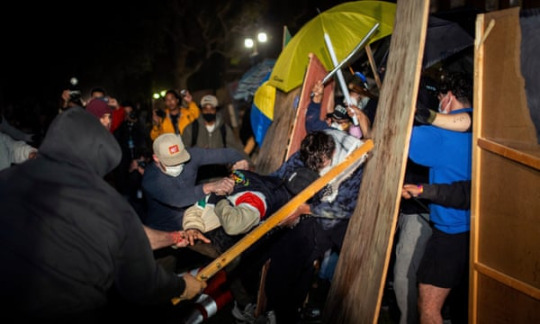
Police had been called in from Princeton to the University of Utah. In Austin, Texas, governor Greg Abbott sent in state troopers on horseback to disperse a peaceful protest; in Georgia, at Emory University, police used pepper balls, stun guns and rubber bullets, and arrested 28 people. (Read Timothy Pratt’s grim and vivid piece about the fallout there.)
As this email is sent, more than 1,500 people have been arrested on more than 30 campuses across 23 states, while many other schools have seen protests that did not lead to arrests. CNN has an up-to-date map. This Washington Post piece gives a detailed sense of how the movement has spread, and how crucial the confrontation between students and the Columbia authorities has been as a catalyst.
The events of Tuesday night felt like a crucible of how intense the confrontations have become – and how they may continue to escalate. Not far from Columbia, at City College of New York in Harlem, 173 people were arrested. At UCLA, fights broke out after a large group of counter-protesters attacked an encampment there (above), launching fireworks into the camp and throwing wood and a metal barrier at those inside it. Dani Anguiano reports that protesters and journalists on the scene said that police looked on for hours before intervening.
“On the one hand, the students have been quite uncomfortable at generating so much media attention – they want the focus to be on Gaza, while doing what they can within their own institutions,” Khawaja said. “But this is a country with a long history of college protests that have shifted the course of our history – and they know that history.”
Archie Bland
0 notes
Text
Plane sailing? | First Edition from the Guardian

Good morning. After two years, three prime ministers, four (or five) home secretaries, one cancelled flight and about 75,000 more people crossing the Channel in small boats, the government finally passed its Safety of Rwanda bill late last night. Anyone reaching for a symbol of how dismal the whole process has been might have found it at 9.39pm, when a power cut plunged the House of Lords into darkness. Maybe Rishi Sunak took out his frustrations with peers on the fuse box.
The endless Westminster fight over the policy has somewhat obscured the more fundamental questions of whether it will actually achieve what it promises, and reduce the number of people making the crossing. Even now it has passed, we may still be months away from knowing the answer. Charities described it as “shameful” and “Orwellian”; Sunak proclaimed it as “not just a step forward but a fundamental change in the global equation on migration”. Meanwhile, another £50m will be sent to the Rwandan government now that the bill is becoming law, taking the total cost to £290m before a single flight has taken off.
For Sunak, the Rwanda policy is as much political dividing line as serious policy initiative – and so he may view events of the last 24 hours as a useful tool for the coming election campaign. Today’s newsletter explains what the votes were about, how the government prevailed, and what happens next. Here are the headlines.

In depth: ‘Perhaps if the government have made more concessions we wouldn’t have to wait so long’

“Enough is enough,” Rishi Sunak said at his press conference yesterday. “No more prevarication, no more delay. Parliament will sit there tonight and vote no matter how late it goes. No ifs, no buts.”
Now that the bill has passed, Sunak can declare victory, at least on the legislative piece of this problem. But the procedural question is only a step towards the Rwanda flights getting in the air – and even if they do, their prospects of solving the crisis in the Channel are heavily contested. Here’s what you need to know.
What issues were settled yesterday?
The initial 10 amendments from the House of Lords had already been whittled down to two – measures which crossbench peer Alex Carlile yesterday told the BBC would be enough to “maintain our legal standards in this country” and make the bill’s progress acceptable.
Although he and many others oppose the principle of the plan more generally, they also grudgingly accept the view put forward in the Commons by former justice secretary Robert Buckland, the only Conservative MP to rebel against the government. In the end, Buckland said, “the unelected house does have to cede authority to the elected house” – although he also said “perhaps if the government have made more concessions we wouldn’t have to wait so long”.
The first amendment, brought by crossbencher David Hope, was an attempt to strengthen the safeguards around the bill’s declaration that Rwanda is a safe country – by appointing the existing monitoring committee, appointed by the British and Rwandan governments, to certify that it is safe and report back to ministers. It said that if the committee found that Rwanda was failing to meet its obligations under the treaty underpinning the plan, it could no longer be treated as a safe place to send refugees – meaning that flights should stop.
The second amendment, tabled by Labour peer Des Browne, said that those who have served the British army “in an exposed or meaningful manner” should be excluded from eligibility for removal. Crucially, that would exempt Afghans who worked alongside British troops there, including interpreters, from being put on Rwanda flights.
How were the votes decided?
When the two houses disagree on aspects of a bill, it can be sent back and forth between them in a process known as ping pong, giving each the chance to respond to changes proposed by the other. The Lords are typically reluctant to continuously defy the will of the elected chamber, and so limit themselves to a couple of rounds of revisions.
It is a measure of the strength of feeling on this issue that the bill was thrown back to the Commons four times more after peers passed the initial 10 amendments. At one point yesterday, Carlile compared the government to a mad travel agent.
Browne’s amendment was the first to fall away, after a partial government concession – not that ministers used that word. The government spokesperson in the Lords, Andrew Sharpe, said that anyone already in the UK who is eligible for the settlement scheme for Afghans would not be sent to Rwanda. Although some pointed out that this was a meaningless concession for those who make the journey in the future, and the SNP’s Alison Thewliss compared the offer to “magic beans”, it was enough for Browne to withdraw.
Shortly after 11pm, after MPs once more rejected the more fundamental amendment about checks on the safety of Rwanda, sources in the Lords said that peers would not vote against the bill again. The bill finally cleared the upper chamber – with no formal oversight function for the monitoring committee attached – shortly after midnight. It is likely to get royal assent and become law today.

Sunak said yesterday that he expected the first flight to Kigali in “10 to 12 weeks” – which could mean June or July. (An enterprising Daily Express journalist, Steph Spyro, spotted documents left behind after the press conference which said the first charter flight was provisionally scheduled for June, and that commercial flights could take people to Rwanda sooner.)
The Daily Telegraph reported that the government expects about 150 people to be be on the first two or three flights. But Sunak refused to put a number on how many would be removed to Rwanda more widely – and the crucial questions now are whether there are more than a few symbolic flights, and whether whatever numbers do happen are enough to deter people from crossing the Channel on small boats.
Sunak set out a series of measures that he said would facilitate the smooth running of the flights, from increased courtroom and detention capacity to training for 500 officials who will be tasked with escorting people to Rwanda. He also said that charter flights have been booked, and that an airfield is on standby.
All of this, Sunak said, will be a “gamechanger”; this useful thread, from home affairs journalist Lizzie Dearden, points out some of the serious questions over the realities of the timetable and process he set out, from whether asylum seekers will be served with the necessary notices in time to be on flights in the summer to whether Rwanda has the capacity to take more than a handful of them.
There are also likely to be further legal challenges from individual asylum seekers before they are put on flights – and a possibility that pilots could refuse to fly if there is serious disruption on board. If the policy is ultimately found to be unlawful, those taken to Rwanda could then be due significant damages and returned to the UK, immigration solicitor Muhunthan Paramesvaran told the BBC yesterday.
Why did Sunak do it this way?
Given how much time has passed since the government’s “emergency legislation” was introduced in December – and since Boris Johnson first announced the plan way back in April 2022 – it might seem a surreal bit of exam-crisis politics to have the issue finally come to a head in a parliamentary session running late into the night. (Here’s a timeline of the whole tortuous process.)
Sunak says that this was Labour’s fault, and that “if Labour peers had not spent weeks holding up the [Rwanda] bill in the House of Lords to try to block these flights altogether we would have begun this process weeks ago”.
But it’s also true that if cross-benchers had been persuaded of the bill’s wisdom, it would have passed much sooner. (The Tories don’t have a majority in the House of Lords, but they are the largest party, with 277 of 790 peers – although, unlike in the House of Commons, the arithmetic somewhat depends on who bothers to show up.) And peers say that it is the government, not the House of Lords, that has allowed the “ping pong” process to drag on for so long: it could have used exactly the same late night process before Easter.
That raises another possibility: that Sunak decided to bring the matter to a head later so that he might more easily make villains of those who opposed it if the flights still fail – and, perhaps, to ensure that it is not possible to reach a definitive verdict on the scheme’s success before the next election.
That theory only makes sense if the Conservatives have little real faith in the policy’s gamechanging potential – and rather than be accountable for a promise that was broken, prefer to talk to voters about a solution that was thwarted, instead.
0 notes
Text
0 notes
Text
What Putin’s victory means for Russia’s future

Archie Bland Good morning. It will not shock you to learn that Vladimir Putin has just been reelected as the president of Russia.
The election that took place over the last three days was a foregone conclusion even before the death of opposition leader Alexei Navalny. In his victory speech last night, Putin sought to present western criticism of the process as the predictable response of Russia’s enemies: “What did you want, for them to applaud us? They’re fighting with us in an armed conflict,” he said last night. “Their goal is to contain our development. Of course they’re ready to say anything.”
Whatever Putin says, the vast 87% of Russians claimed by Russia’s electoral commission to have backed Putin appears to be an inflated figure. But the best available polling still shows him with substantial support among the Russian public. That may partly be the result of a fatalistic sense that there is no other option in Russia – and events since Navalny’s death have done little to dispel that view.
Today’s newsletter, with the Guardian’s Moscow correspondent Andrew Roth, explains the results, the state of the opposition after Navalny’s demise, and what a new Putin term will look like.
In depth: ‘Every person who might have challenged Putin has been destroyed or co-opted’

Putin won 53% of the vote in 2000, 71% in 2004, 64% in 2012, and 77% in 2018. By that yardstick, 87% looks like a predictable progression.
“That number is goofy,” Andrew said. “It’s getting up there into the stratosphere, with the kind of numbers we used to only get in the most despotic regions of Russia, like Chechnya under Ramzan Kadyrov. The fact that Putin is claiming to win at that rate is more a reflection of his state of mind than the electorate … they used to have some restraint because they wanted to say this is a democratic country. It has turned into a coronation. They’re not worried about perceptions any more.”
Putin’s support
While the results are inflated, it is also true that Putin is the only prominent politician in the country with a wide base of support. “This is by no means a free and fair election,” Andrew said. “But you also have to acknowledge that he is the most popular politician in the country, and if there was a free election he would very likely win it.”
In assessing the real extent of his popularity, though, it’s also necessary to say that he has repeatedly cut off any opposition movement that might have competed against him before it had the chance to develop. “Every single person who might have challenged him has either been destroyed or co-opted by the system,” Andrew said. “Elections are about choices, and Russians don’t have any others.”
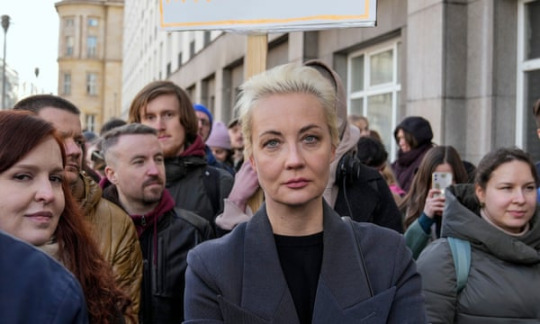
Despite the comprehensive nature of Putin’s victory, there were signs of opposition on view yesterday, when some dissenting voters heeded the “Noon against Putin” call endorsed by Alexei Navalny’s widow Yulia to arrive at polling stations en masse at midday to form crowds and provide a symbolic – and relatively safe – protest.
Although it is impossible to arrive at exact figures, there were long lines at polling stations in Moscow and other cities, while exiled Russians also heeded the call at embassies around the world – including Yulia Navalnaya herself, who voted in Berlin (above). Dozens visited the cemetery in Moscow where Navalny is buried to leave their ballot papers on his grave, while human rights group OVD-Info said at least 80 people had been detained for election protests.
“They did what they had to do,” Andrew said. “They made sure their voice was part of the story about Putin winning this election – it’s an important symbolic protest, at least. But clearly this won’t change anything today. They will hope that it is part of building a protest base for the future with the cohesion and confidence to take action.”
There was never much chance of vast crowds showing up at any one place: the population is diffuse across a very large country, and most polling stations in Russia have fewer than 3,000 registered voters assigned to them. “The bar is pretty high to take part – you have to not only oppose the government, but also be willing to risk arrest,” Andrew said.
Managing dissent since Navalny’s death
Yesterday’s protests are not the first display of opposition to Putin since the death of Alexei Navalny. Rubber ducks have popped up in surprising places, like in a rose bush in St Petersburg or in a tributary of the Volga river, in a repurposing of a symbol that once stood for his fight against corruption. And if that seems like a tiny and relatively risk-free way to speak up, the thousands who came to his funeral – and many more who queued to visit his grave thereafter – look like a more tangible measure of disquiet.
“The funeral was quite significant,” Andrew said. “People chanting down with Putin – it was a symbolic recognition of the fact that there are still people in Russia who are against this war.”
At the same time, he cautioned, the state may be perfectly comfortable with such protests if they stay at a controllable scale. “They are pretty deft at managing protest and opposition,” Andrew said. “They could have refused to release his body, or forced the funeral to be held outside Moscow, but they recognised that this might be a moment to let the foot off the gas a little bit. These kind of symbolic acts are important, but nobody is going to be embarrassed or made fun of into giving up power.”
Last night, Putin claimed that he had agreed to a prisoner swap that would have seen Navalny’s release shortly before his death in an Arctic prison. “I agreed under one condition: we swap him, and he doesn’t come back. But such is life,” he said. “When things like that happen you cannot do anything about it – that’s life.”
The opposition’s response
The continued risks for those leading the opposition to Putin were made clear last week, when Leonid Volkov, a senior aide to Navalny in Lithuania, was attacked with a hammer outside his home.
“There’s not much doubt that that was ordered or motivated by the Russian government,” Andrew said. “It isn’t clear if they were trying to kill him – but it is clear that they are saying, you can be attacked anywhere, and reached anywhere. So there is certainly concern about more violence against opposition figures wherever they are in the world.”
In the month since Navalny’s death, his team have not yet put forward a concrete plan for the future – and there have been claims of an unwillingness to work with other opposition figures to present a united front. But, said Andrew: “There have been some signs of more collaboration.” Maxim Katz, another prominent opposition figure, “has been quite supportive of the Navalny team. And you’ve seen other opposition groups coming together behind the idea of voting for anyone other than Putin – although whether you should take part in a rigged election at all remains controversial.”
Yulia Navalnaya, meanwhile, “still seems to be working out what her role will be. I think it’s clear that she won’t be a figurehead, exactly, but she will be one of the symbolic leaders. She will need the support of people with more experience of the logistics of opposition. Many of them are in jail or in exile – so it’s hard to say exactly what the way forward will be.”
Putin’s new term
In this excellent primer on the outlook for Russia after the election, Andrew and Pjotr Sauer report that while his team sought to push him towards a more positive agenda, Putin was determined to focus on the war.
“It would have been the smarter political move to focus on social spending, for example,” Andrew said. “But he’s not done that. He’s ready to make the war a sacred mission for the country in the way world war two was, and to position Moscow as pushing back against the decadent west.”
The war has already transformed the economy, with 7.5% of GDP now spent on the military, the highest percentage since the end of the Soviet Union. “In the future, your part in the war effort is going to be a clear litmus test of whether you can play a role in leading Russia,” Andrew said.
“You’re seeing, for example, deputy chief of staff Sergei Kiriyenko visiting Avdiivka [a city in Ukraine] in a flak jacket – it’s almost absurd, this guy is a political nerd cosplaying at being a general. But they know they have to show that they’re on board. So that’s the change in Russia now – the transformation into a state that is totally focused on war.”
0 notes
Text
Can Biden win back Black voters?


The Guardian 11/01/2024
Thursday briefing:
Why Biden is losing some Black voters – and how he plans to win them back
No Republican presidential candidate has received more than 13% of the votes of Black Americans since the civil rights era. In the race against probable nominee Donald Trump, Black voters are again likely to be Democrat president Joe Biden’s most reliable constituency. But in recent months, that support has started to erode.
This week, Joe Biden has tried to do something about it, with a visit to the Black church in South Carolina where a white supremacist killed nine people in 2015. He linked Trump’s 2020 election denialism to the Confederate rebellion over slavery that prompted the civil war, and told his audience: “Once again, there are some in this country trying to turn a loss into a lie.”
But even among his supporters, there are many who fear that Biden’s campaign is not giving Black voters enough to get excited about – and say that if he fails to do so, he could hand Trump the keys to the White House. And last night’s Republican debate between outsiders Nikki Haley and Ron DeSantis did little to persuade anyone that Trump will not be Biden’s opponent.
Today’s newsletter, with the Guardian’s Washington DC bureau chief David Smith, is about why Biden’s support has declined among Black voters, and what he needs to do to fix it.
In depth: ‘As always, the election’s going to come down to a handful of votes’

The serious concerns for the Biden campaign began with a New York Times poll in November, which found that 22% of Black voters in six battleground states planned to back Trump in 2024. Other polls brought similarly ominous news: 20% of Black voters nationally backing Trump in an NBC News poll, 23% according to CNN, and just 63% backing Biden according to GenForward/University of Chicago.
Those are still big majorities for Biden, and white voters are far more likely to support Trump. But in a race that will be decided at the margins, it is a significant shift. In 2020, 92% of Black voters supported Biden for president, according to a study by Pew Research Center. Biden has also seen a sharp decline among Latino voters, with 34% supporting him now compared with 65% in 2020.
“It is a relatively small number of people, but it’s a crucial part of the Democratic coalition,” David Smith said. “Presidential elections are so absurdly close, and last time Biden won by 7m in the popular vote, but 40,000 votes in the three states that put him over the top in the electoral college. He thanked Black voters in his victory speech in 2020, which was a sign of how important they were to his victory.”
In that speech, Biden said: “You’ve always had my back, and I’ll have yours.” But not everyone is persuaded that he has made good on that bargain.
Why some Black voters are turning away from Biden
When David visited the battleground state of Georgia, where African Americans were crucial to Biden’s narrow 2020 success, he heard from Black voters who feel that Biden has fallen short on a range of campaign promises, from tepid action on voting rights and police reform to failing to decriminalise marijuana possession, an offence for which Black people are far more likely to be arrested.
“No community is a monolith,” David said. “The specific issues naturally depend on who you talk to, and they vary by age, geography, class. Many would cite things not specific to the Black community – a sense of economic malaise, even though the economy does appear very healthy. A lot of people mentioned student loan forgiveness. And then there are the issues that are more specific, like Biden’s promise to deliver racial justice.”
“There’s a lot of broken promises, a lot of a lack of integrity,” philosophy student Dejaun Wright told him. “A lot of the things that he promised he’s offered either with a caveat or he just hasn’t offered at all. It’s a slap in the face.”
There is also a suggestion that some Black voters are weary of being taken for granted by the Democrats and feel they should have more to show for decades of consistent support. Pete Giangreco, a Democratic strategist, told Politico in November that he heard “less about Trump” and more “an attitude … that, ‘I’ve been voting Democratic for 50 years, my community has been voting Democratic for 50, 60 years, and we don’t have much to show for it.’”
The drop in Biden’s support is concentrated among Black men and younger voters – a pattern repeated across different ethnic groups. Black voters under 50 were twice as likely to vote Republican in the 2022 midterms than their older peers, Reuters reported, while the New York Times found that 27% of Black men supported Trump against 17% of Black women.
Younger Black voters are much more likely than average to support a ceasefire in Gaza or say that the US should not be involved in the conflict there at all. “Some of these voters aren’t going to turn to Trump,” David said. “But a third party candidate like Cornel West, who is being very clear in a call for a ceasefire, may look attractive to them.”
Cliff Albright, a co-founder and executive director of the Black Lives Matter Fund, told David that even if Biden went further on cancelling student debt, new gun legislation, and climate change – three key issues for young Black voters – “many of these folks that right now are furious about what’s going on in Gaza, none of that would change their minds”.
Celinda Lake, a pollster who recently ran a round of focus groups, told Politico that she heard from Black voters who feel that their communities are missing out because of the spending on foreign wars. In Detroit, a woman told her that while Ukraine got billions, “we’re in Detroit, and we get nothing”.
Among some Black men, a sense that Biden has not made good on his promises has sat alongside a perception that Trump’s racist language matters less than his promise of greater economic opportunities.
Trump is leaning into that theme. Jason Miller, a campaign senior adviser, wrote on X/Twitter this week that Biden “has done more damage to the African American community than any president in modern history … everybody knows we were better off with President Trump”.
What Biden is doing about it
Biden’s speech at Emanuel African Methodist Episcopal Church in Charleston, South Carolina, this week was seen as a direct attempt to persuade Black voters that they are better off with him, David said. “But there was also a sense that he needed to be scrappy, and hit Trump – to energise Democrats who want to see a fighter on the big picture, and to show some genuine passion.”
The most striking parts of his speech – which was interrupted by protesters calling for a ceasefire in Gaza - were those that drew a link from the South’s support of slavery during the civil war and the Trump campaign. The latter was described as “the old ghost in new garments”. He also made pointed references to the “poison” that devastated the church’s community nine years ago: “What is that poison?” he asked. “White supremacy. Throughout our history, it’s ripped this nation apart. This has no place in America – not today, tomorrow or ever.”
At the same time, the Biden campaign is said to recognise that a central goal has to be to tell Black voters a positive story about its policy record – and Biden pointed to the fact that he had appointed the first Black female supreme court justice, noted record-low levels of Black unemployment, and celebrated legislation that has lowered the cost of prescription drugs.
There are plenty of Democratic strategists who chafe at the idea that Biden has failed Black voters.
Terence Woodbury, a Democratic pollster, told ABC News that “when I sit in focus groups with young Black voters and ask what [Democrats have] done to make their lives better, they’re hard pressed to come up with an answer, despite this administration delivering on much of the Black agenda. That’s the communication challenge that we have a year to overcome.”
“Ordinary voters are mostly not tuning in yet – they are busy living their lives and worrying about their jobs and what’s for dinner,” David said. “It’s certainly true that there is a lot of time, and as we get nearer election day, they may be reminded that Trump is a demagogue and they don’t want that. But it is, as always, going to come down to a handful of voters in swing states.”

2 notes
·
View notes
Text
Niet iedereen is blij met de biografie van Loesje, het mysterieuze en snedige postermeisje
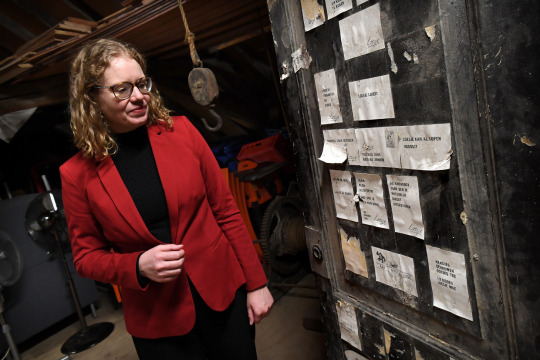
Biograaf Fleur van der Bij bij Loesje-teksten op de wc-deur van een voormalig kraakpand in Zevenaar. Beeld Marcel van den Bergh / de Volkskrant
De Volkskrant - Pieter Hotse Smit10 november 2023, 15:22
Veertig jaar geleden ontstond Loesje, het mysterieuze postermeisje met haar snedige kijk op de wereld. Nu is er een biografie, maar de Loesje-makers zijn daar niet blij mee. ‘Haal je Loesje uit de anonimiteit, dan breng je schade toe aan de transformerende uitwerking van haar glimlach.’
In Café Meijers aan de Beekstraat in Arnhem herinnert niets aan het beroemde meisje dat er precies veertig jaar geleden ‘werd verwekt’. Terwijl een van haar meest legendarische uitspraken toch niet zou misstaan in een kroeg: ‘Aan het eind van m’n geld houd ik altijd een stuk maand over’.
Het zijn de woorden van Loesje, het vrolijke postermeisje dat bijna iedereen kent, maar tegelijkertijd niemand.
Met snedige, immer actuele teksten zoals ‘Leven is meervoud van lef’ tot ‘Sociale zekerheid, dat je zeker weet dat je buren je teruggroeten’, kleuren de zwart-wit beletterde posters van Loesje al sinds 1983 straten en pleinen. Nu is er een biografie van Loesje. Of eigenlijk: van het activistencollectief achter de mysterieuze postergirl – en daar is niet iedereen blij mee.
Reactie op tijdgeest
Loesje was begin jaren tachtig de opgewekte reactie op de grimmige sfeer van die tijd. Die van ‘anti’ (kernenergie), ‘stop’ (met oorlog) en ‘tegen’ (kruisraketten). In de ‘sfeer van negativiteit, agressie en geweld’, zo schrijft biograaf Fleur van der Bij in haar boek, opperden zes activisten van een Arnhemse woongroep op een dag aan de keukentafel: ‘Wat als we nu eens ergens vóór zijn?’
De activisten besloten hun positieve geluid via posters te verspreiden. Om hun boodschap te laten beklijven, moest een raadselachtige figuur worden bedacht, luidde de conclusie aan de keukentafel. Iemand die prikkelde, scherp was en aan het lachen maakte. Over een ding zou het zestal het eens zijn geweest: het moest een meisje worden.
De woongroepleden hadden zich van de keukentafel verplaatst naar Café Meijers toen ene Loes van Schaaijk, kunstacademiestudent, binnen kwam lopen. Haar grote bos zwarte krullen en vrolijke uitstraling gadeslaand wisten de zes het onmiddellijk: ‘Loesje’, dat moet het worden.
Een jarenlange fascinatie
De vele Loesje-teksten die al snel tot ver buiten Arnhem illegaal in de publieke ruimte werden geplakt, wisten biograaf Van der Bij al jong te raken. Dat ze in het Friese dorp waar ze opgroeide werd gepest vanwege haar Loesje-agenda, weerhield haar er niet van haar grote voorbeeld te citeren in de havo-almanak: ‘Wees jezelf, er zijn al zoveel anderen’.
Op latere leeftijd sloot Van der Bij zich in Groningen aan bij een van de Loesje-regiogroepen, die toen nog in het hele land waren gevestigd. Nog weer later schreef ze kortstondig voor de Berlijnse tak van Loesje. Gefascineerd door de mythe die Loesje desondanks voor haar bleef, begon Van der Bij vier jaar geleden met wat Loesje. De biografie zou worden.
Het boek ligt op een zaterdagmiddag op tafel in een gebouw in Zevenaar, een ander mythisch Loesje-bolwerk. Een pand dat destijds werd gekraakt door onder meer Loesje-schrijvers van het eerste uur. Op zolder is een wc-deur met de eerste spreuken bewaard gebleven.
‘Er staat te veel in waar ik niet achter sta’
Inmiddels is in het pand restaurant Eet-Lokaal gevestigd. Net als Van der Bij vanachter een kop thee begint te vertellen over de Loesje-schrijvers van het eerste uur, loopt er, stomtoevallig, eentje binnen. Gelijktijdig met het interview blijkt een verdieping hoger een krakersreünie gaande. De vrouw, die Yoeke Nagel (61) blijkt te heten, stapt op Van der Bij af en zegt: ‘Ik kom niet naar je boekpresentatie. Er staat te veel in waar ik niet achter sta.’
Nagel is een van de mensen die door Van der Bij werden geïnterviewd, maar heeft daar nu spijt van. Ze leest in de biografie te veel een poging tot ‘scoopen, onthullingen doen’, licht ze later telefonisch toe. ‘Maar het maakt niet uit of wij aan een keukentafel zaten of voor mijn part in een golfslagbad. Ook niet dat wij tekstuele methoden van Lenin toepasten.’
Van der Bij zocht en vond voor haar biografie dé Loes van Schaaijk uit Café Meijer. Ook daar is Nagel niet over te spreken, omdat een biografie over Loesje volgens haar niet zou moeten gaan over of er iemand was die Loes heette, maar over wat de kracht is van Loesje ‘als gereedschap in het verwoorden van een verlangen voor verandering’ en of die nog werkt in deze tijd.
De oorspronkelijke leden van het postercollectief menen van wel, blijkt uit de ‘Vooruitblik van vijf Loesje-oprichters’, die als tegemoetkoming door de uitgever is opgenomen als bijlage in het boek. Hierin geeft de generatie die ‘van de dijk bij Dodewaard werd weggespoten’ zeven tips aan de generatie die nu op de A12 hetzelfde overkomt. Het zijn handvatten om de moed erin te houden. Te beginnen met wat gelezen kan worden als eerste medicijn tegen de polarisatie van deze tijd: creëer ‘een plek waar mensen welkom zijn, ook met ‘ongewone’ gedachten’.
Vrijheid van meningsuiting
De kritiek op haar boek steekt Van der Bij. Ze wordt nu bekritiseerd door uitgerekend de mensen achter het medium dat haar als enige wildplakker in het dorp ‘Fucking vrijheid van meningsuiting, Tjalleberd!’ deed roepen. ‘De makers van Loesje waren voorvechters van vrijheid van meningsuiting, maar nu ineens niet als het over Loesje zelf gaat’, concludeert ze cynisch.
Yoeke Nagel noemt die kritiek onterecht. Waar het haar om gaat: ‘Haal je Loesje uit de anonimiteit, dan breng je schade toe aan de transformerende uitwerking van haar glimlach.’ De huidige schrijvers van Loesje werkten om die reden niet mee aan het boek. ‘We koesteren het mysterie dat de afgelopen veertig jaar is opgebouwd’, zegt Daan, die niet met zijn achternaam in de krant wil. ‘De kracht is dat dan iedereen haar kan zijn.’
1 note
·
View note
Text
Dit is het moment om in actie te komen

Beste,
Je zou het haast missen naast de verkiezingsuitslag van gisteren... Een uitslag die ons óók voldoende werk oplevert (PVV ziet preventie op het gebied van voedsel en gezondheid als 'betutteling'). Maar het Europees Parlement heeft gisteren het langverwachte pesticidenplan weggestemd. Het plan hield een belofte om in 2030 de helft minder pesticiden te gebruiken.

Een schande voor Brussel
Onze afgevaardigde in Brussel kreeg het nieuws gistermiddag door. Toevallig was ze bij ons op kantoor in Amsterdam, samen met alle campaigners uit de verschillede Foodwatch-kantoren. Ontzet bracht ze het nieuws over aan de groep. Ik kan je vertellen dat we er even stil van waren. Eerst de stemming over glyfosaat, waar de Europese Commissie besloten heeft het gif nog eens 10 jaar toe te staan, en dan nu dit? Wat zijn ze toch aan het doen daar in Brussel?!
Maar, breng dit nieuws aan een groep van tientallen Foodwatch-campaigners, en je krijgt er een enorme strijdlust voor terug. We zijn direct plannen gaan maken en zullen deze de komende maanden uit gaan rollen.
Pesticidenvrije landbouw in het regeerakkoord?
Naast die nieuwe acties en gesprekken in Brussel (want we gaan achterhalen hoe dit voorstel verworpen kon worden), hebben we nu nog onze campagne voor de formateurs lopen. Punt vier van ons vijfpuntenplan betreft: pesticidenvrije landbouw. Dat er wat gaat veranderen in Nederland mag duidelijk zijn; de verkiezingen lieten een nog niet eerder vertoonde verschuiving zien. De uitslag gaat hoe dan ook gevolgen hebben voor onze voedselomgeving, milieu en samenwerkingen op Europees niveau. Laten wij er dan in ieder geval voor zorgen dat één van die veranderingen een goed voedselbeleid is. Teken (of deel) het plan hier!
Na de formatie gaan we de campagne doortrekken naar de Europese verkiezingen. Nieuwe Europese voorstellen en regelgeving met betrekking tot pesticiden zullen pas na die verkiezingen worden gestart. Hoe meer mensen het vijfpuntenplan ondertekend hebben, des te beter zijn we voorbereid om het verschil te kunnen gaan maken in Brussel. Teken of deel het plan dus vooral, als je dat nog niet gedaan hebt.Teken voor beter voedselbeleid ››
Samen staan we sterk tegen de pesticiden-lobby
De Oostenrijkse parlementariër Wiener, onderhandelaar van het Parlement, beschuldigde de Europese christendemocraten ervan dat ze de bestrijdingsmiddelenindustrie aanpassingen hebben laten schrijven aan het wetsvoorstel. Ook noemde ze de een stevige lobby van de landbouwsector. "De Duitse lobby was het ergst. Ik ben voor gek uitgemaakt en heb ook meerdere doodsbedreigingen gehad." lezen we bij de NOS.
Het maakt pijnlijk duidelijk wie we tegenover ons hebben. Een machtige lobby uit de industrie, die hun winstbelangen boven onze gezondheid stellen. Dit kan en mag niet gebeuren!
Ik wil vandaag dan ook mijn dank uitspreken dat jij ons werk ondersteunt. Alleen samen kunnen we deze campagnes voeren, en samen staan we zoveel sterker. Mocht je ons een beetje extra willen ondersteunen, dan zijn we daar natuurlijk ook ontzettend dankbaar voor!Ik doe een (extra) gift ››
Dankjewel voor jouw steun. Samen gaan we een einde maken aan pesticiden en zorgen we voor gezond, veilig en eerlijk voedsel. Daar ben ik van overtuigd!
Nicole van Gemert Directeur foodwatch Nederland
0 notes
Text
How should we talk to children about war?

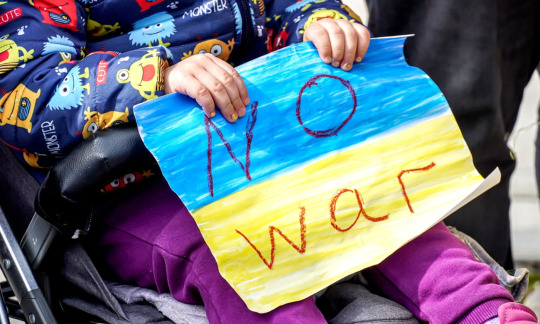
27/10/2023
Friday briefing:
Explaining conflict to young people is hard – but can help with their resilience
With the cost of living crisis, political chaos, and two full-blown wars, the news cycle is possibly the bleakest it’s ever been. Waking up to more bad news every day is hard. It’s hard for you to read, and it’s hard for us to report on. But it’s hardest of all for the children – in Gaza, Israel and Ukraine, of course, but also those hearing about it from a distance and perhaps encountering the horrors of war for the first time.
In less than three weeks, it is thought that more than 2,360 children have been killed in Gaza, while more than 30 children were killed by Hamas during the attack in Israel and dozens have been taken hostage. Unicef described the “simply staggering” child death toll as “a growing stain on our collective conscience” as it called for an immediate ceasefire to stem the loss of young lives.
For today’s newsletter, I asked educational and child psychologist Prof Vivian Hill to talk about the impact that war has on still forming minds, and for her tips on how we should talk about the horrors of conflict with children. But first, the headlines.

In depth: ‘Children have a remarkable capacity to cope’
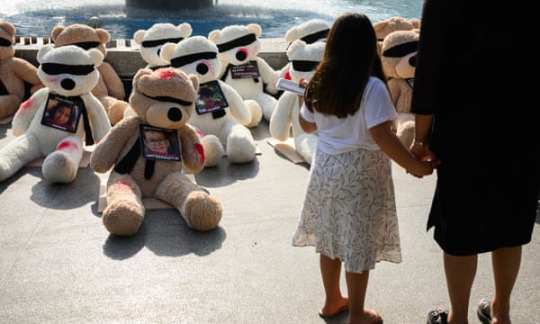
Almost half (47.3%) of the people living in Gaza are under 18, making it one of the youngest populations in the world. With so many children living in a war zone, it is perhaps not so surprising that many have been killed, but the numbers are still shocking. As well as the dead, 5,364 kids have been reported injured in the attacks – which Unicef works out as more than 400 children killed or injured every day since the conflict began on 7 October.
“The killing and maiming of children, abduction of children, attacks on hospitals and schools, and the denial of humanitarian access constitute grave violations of children’s rights,” Adele Khodr, Unicef’s regional director for the Middle East and North Africa, said. “Unicef urgently appeals on all parties to agree to a ceasefire, allow humanitarian access and release all hostages. Even wars have rules. Civilians must be protected – children particularly – and all efforts must be made to spare them in all circumstances.”
Should you try to shield your children from the horror of war?
“It’s impossible to stop children from learning about the war,” Hill says. “They’re going to hear about it in the playground at school, or from their phones. Creating the right environment for them to ask questions they may have about the conflict is the most important thing.” That’s even more true for certain communities: some Jewish schools felt forced to shut their doors or tell children not to wear their uniforms in public, while Muslim children arriving at mosques for prayers have been met by police guarding the doors due to the “heightened risk” caused by the Israel-Gaza conflict.
Hill says many parents worry that learning about war is “denying children their innocence”, but she says there is never a good time for kids to learn that not everyone in the world is nice to each other. “It may well be earlier than you would have liked to broach the topic of war with your children, but take this as an opportunity to provide them with the right tools to deal with it – to build up resilience.”
As a parent or carer, Hill says, you are uniquely placed to know how much information your children require and how to talk to them depends on their age and development. The most important thing, she says, is to listen to the child and let them guide you in helping them.
“Some children will need reassurance that they are safe, while older children may need support to understand the complexities of the situation,” she says. “By taking the time to listen, and to help them process their own thoughts and emotions about the conflict, parents can provide comfort and help children cope with their difficult feelings.”
Ask your children how they feel
Hill, who has worked as a child psychologist for more than 20 years and now trains other people in child and educational psychology, says it is very important to put your own emotions to one side and let the child talk freely. “The news of war is distressing for all of us,” she says. “But it is important to be careful not to put your thoughts and worries into their heads.”
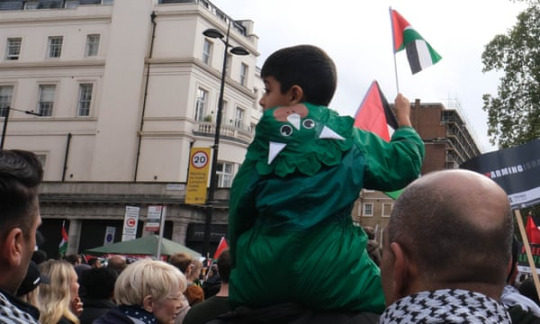
Be careful about managing your distress. “If they see you’re anxious, worried or crying, they will take that onboard and worry as well.”
She suggests using open questions to explore their feelings. “Ask your children what they have heard and seen and how they are feeling, this allows them to introduce their personal perspectives and understandings first, so you can focus on their needs rather than your assumptions about how they might be feeling.”
Acknowledge the horror of war
As they grow up children inevitably develop their understanding of social injustice, inequalities and the horror of war. “This can make them feel upset, angry, frightened or unsafe, helping children learn how to process difficult information, feelings and emotions is a key role for parents and carers,” says Hill, who is a member of the British Psychological Society’s division of educational and child psychology.
She says it is important to regulate what news children are consuming, and points out that the news at 6pm uses less graphic images than the news at 10, for example. The BBC’s Newsround is the best child-friendly source of information, in her view.
“After seeing anything affecting, talk to your child about it, acknowledge the horror of it, but also don’t dwell on it.” She suggests doing something together with your child after seeing anything distressing. “Go out of for a walk, take the dog out, do something different.”
What to tell your children depends on how old they are
For younger children, only give them minimal details and in a manner they can understand. She suggests for anxious children that may worry what they’re seeing on the news could happen to them, “It might be helpful to look at a map together and see that it is happening a long way away, and not impacting people here.”
She says distance shouldn’t be used to minimise the importance of a conflict itself, but can have a big impact if children are concerned they could be at risk.
Hill says you might feel your children are too young to learn about war, but “they have a remarkable capacity to cope with feelings” and “[talking to them about conflict] may help to build their resilience for the future”.
“For adolescents they may have a more nuanced understanding of what’s happening,” says Hill, who is programme director of the UCL Institute of Education doctorate in child, adolescent and educational psychology. “In that case it can be helpful to do a little research together looking at the history of the conflict, and understand that both sides believe they have genuine cases.
“The most important thing is shifting the conversation towards the understanding of peace. Talking about the importance of ending wars, on keeping people safe, and promoting peaceful solutions, that will help your children feel reassured.”
Vivan, who has spent much of the past three weeks visiting schools to help teachers learn how to help their pupils deal with the impact of war, says she has been heartened by what she has heard unprompted in the playground.
“I heard somebody saying something unpleasant about a child whose family was linked to one side of the conflict,” she said. “Another child interrupted to say ‘It’s nothing to do with that person or their family, and they don’t get to choose what is happening, but what needs to happen is peace now’.
“It was a remarkably mature and well-researched position for a child of 14,” Hill says. “And it shows that young people can be a tremendous force for good. If we can all learn from that child and push that message that peace is the only way to solve this.”
Jamie Wilson
Head of International News, The Guardian
0 notes
Text
De Franse supermarkt Carrefour communiceert krimpflatie op schapkaartjes, hypocriet of niet?

Beste,
We zijn nog maar een paar protestmails verwijderd, en dan zijn er 10.000 foodwatchers die oproepen voor transparantie bij krimpflatie! Bij krimpflatie krijg je minder product voor meer geld. Voedselfabrikanten verkleinen namelijk in het geniep de inhoud en/of de verpakking, waardoor de prijs per kilo of liter sterk stijgt. Actie hiertegen is hard nodig en niet alleen in Nederland.
Want onder druk van onze collega's gaat Frankrijk er heel anders mee om dan onze regering. De Franse Minister van Financiën heeft eind augustus aangekondigd dat er strenge wetgeving komt om de voedselindustrie en supermarkten te dwingen tot heldere communicatie wanneer krimpflatie voorkomt.

Daaropvolgend heeft de Franse supermarktketen Carrefour half september aangegeven om zelf alvast actie te ondernemen door schapkaartjes op te hangen bij producten waar krimpflatie is toegepast. Al wijzen onze collega's bij Foodwatch Frankrijk erop dat Carrefour zelf bijdraagt aan het probleem. Zo hebben ze maar een aantal producten uitgelicht die krimpflatie toepassen, en daar zitten natuurlijk geen merken tussen van Carrefour zelf. Hypocriet of niet? Het is in ieder geval hoog tijd dat ook de Nederlandse regering strenge regels voor voedselproducenten en supermarkten gaat opstellen en zo consumenten beschermt tegen deze slinkse praktijken. Al helemaal nu weer blijkt dat de afgelopen maand vooral supermarkten en andere verkopers van eten en drinken de omzet weer met 6% zagen stijgen. Tegelijkertijd kochten consumenten 3,2 procent minder aan producten.
Ook de Duitse regering heeft serieuze plannen om stappen te ondernemen tegen krimpflatie. De Minister van Consumentenbescherming wil namelijk dat verpakkingen van dezelfde grootte met verminderde inhoud (krimpflatie dus) ontoelaatbaar zouden moeten zijn. Hetzelfde zou gelden als de inhoud hetzelfde blijft en de verpakking wordt vergroot.
Nederland kan niet achterblijven. Doe mee met onze actie!
Onlangs vonden wij weer volop producten waar krimpflatie op toegepast is We hebben drie voorbeelden voor je uitgelicht.

Bertolli pastasaus in zak Piccante: was 500 gram, is nu 460 gram (prijs per kilo +90%)

Patak’s Mini Naan Plain (4 stuks): was 240 gram, is nu 188 gram (prijs per kilo +54%)

Vivera Tofu Natural: was 500 gram, is nu 400 gram (prijs per kilo +37%)
Stuur een protestmail en eis transparantie op krimpflatie!
Trouwens, we hebben ook weer wat nieuws ontdekt. Een nieuwe truuk, namelijk "cheapflation." Dit gebeurt wanneer fabrikanten goedkopere ingrediënten gebruiken dan voorheen, zoals bijvoorbeeld boter vervangen door palmolie in een product. Deze praktijk is echter lastig te ontdekken. Daarom willen we jullie vragen om het ons te laten weten als je dit tegenkomt in de supermarkt. Bovendien hebben we nog geen Nederlandse term hiervoor bedacht. We dachten aan “skeerflatie” of “vrekflatie”." Heb jij een idee, laat het ons dan weten!

Frank Lindner, Campagneleider

1 note
·
View note
Text
Klimaatactieconferentie 1 oktober: programma bekend📢

Beste,
al meer dan 170 mensen hebben zich opgegeven voor de actieconferentie volgende week zondag in Utrecht! Dit zijn mensen die actief zijn bij uiteenlopende klimaatorganisaties. Dit is erg goed nieuws. Samen willen we namelijk de balans opmaken over de klimaatbeweging.
We hebben als beweging de afgelopen jaren namelijk stappen gezet. De blokkades van XR hebben bijvoorbeeld fossiele subsidies bovenaan de agenda gezet. Maar hoe gaan we verder? Wat voor lessen trekken we uit de strijd de afgelopen jaren? Op wat voor punten kunnen we de krachten bundelen?
Het programma ziet er als volgt uit:
12.00 - 12.30 inloop met koffie en thee
12.30 - 13.00 openingspanel: terugblik op het afgelopen actieseizoen
Sieger Sloot (XR), Andy Palmen (Greenpeace), Charlotte Braat (oa. XR, Reclame Fossielvrij, Netwerk Klimaat FNV)
13.00 - 13.45 ronde 1 workshops
14.30 - 15.15 ronde 2 workshops
16.00 - 17.00 slotpanel: rond welke thema's gaan we de druk opvoeren?
met oa. Danielle Hirsch (Both Ends), Donald Pols (Milieudefensie), Anne Kervers (XR) en Liset Meddens (Fossielvrij NL)
17.00 borrel
Het is nog steeds mogelijk om je op te geven via het formulier op onze website.
Programma workshops
We hebben de afgelopen maanden veel voorstellen in inzendingen ontvangen voor de workshops. We hebben hieruit een selectie gemaakt van acties die vaak al door verschillende organisaties gedragen worden en potentie hebben om meer mensen te activeren. Hiernaast houden we ruimte om op basis van actualiteit nog workshops toe te voegen. Er is ook een tijdlijn waarin verschillende organisaties hun acties kunnen aankondigen.
Ronde 1
De grote mars voor klimaat en rechtvaardigheid op 12 november in Amsterdam
Jeugd/Jongerenbeweging van Tegenwoordig (en de toekomst)
Gratis, bereikbaar, goed, lonend en groen OV in publieke handen
Hoe klimaatrechtvaardig is kernenergie? Wat is nodig om nieuwe centrales tegen te houden?
Klimaatstrijd & Agro-industrie. Strijdbare allianties met groene boeren
Ronde 2
Help, mijn universiteit zit in fossiel! Tactieken om banden met fossiele bedrijven te verbreken
Klimaat & Gezondheid, tijd voor een een Conference of the People
Hoe verbreden we de strijd tegen fossiele subsidies?
Stop de verslaving aan gas, geen nieuwe LNG-terminal in Rotterdam!
Klimaatrechtvaardigheid = noodzaak van een wereld zonder grenzen
Kijk voor meer informatie over het programma en de inhoud en organisatoren van de workshops op onze website.
Praktisch
🏢 Locatie: Het Huis, Boorstraat 107 Utrecht (op loopafstand van CS) 🇬🇧 Translation to English is possible 👶 Kinderopvang voor kinderen vanaf 4 jaar. Opgeven van te voren
🪧 Informatiemarkt waar je als organisatie je campagne en acties kunt toelichten 🎟️ Toegang is gratis, maar een vrijwillige bijdrage van 5 euro wordt op prijs gesteld
Meld je aan
Over ons
De klimaatactieconferentie wordt tweemaal per jaar georganiseerd. Doel hiervan is om activisten uit verschillende organisaties en campagnes samen te brengen, strategische discussies te voeren en samen nieuwe initiatieven te nemen. De conferentie wordt op het moment georganiseerd door activisten die onder meer aangesloten zijn bij End Fossil Occupy, Internationale Socialisten, Scientist Rebellion en Wise. Zij doen dit in samenwerking met Fossielvrij NL, FNV, Greenpeace, Milieudefensie, TNI en XR.
Voor updates kun je ook ons Telegram kanaal volgen.
0 notes
